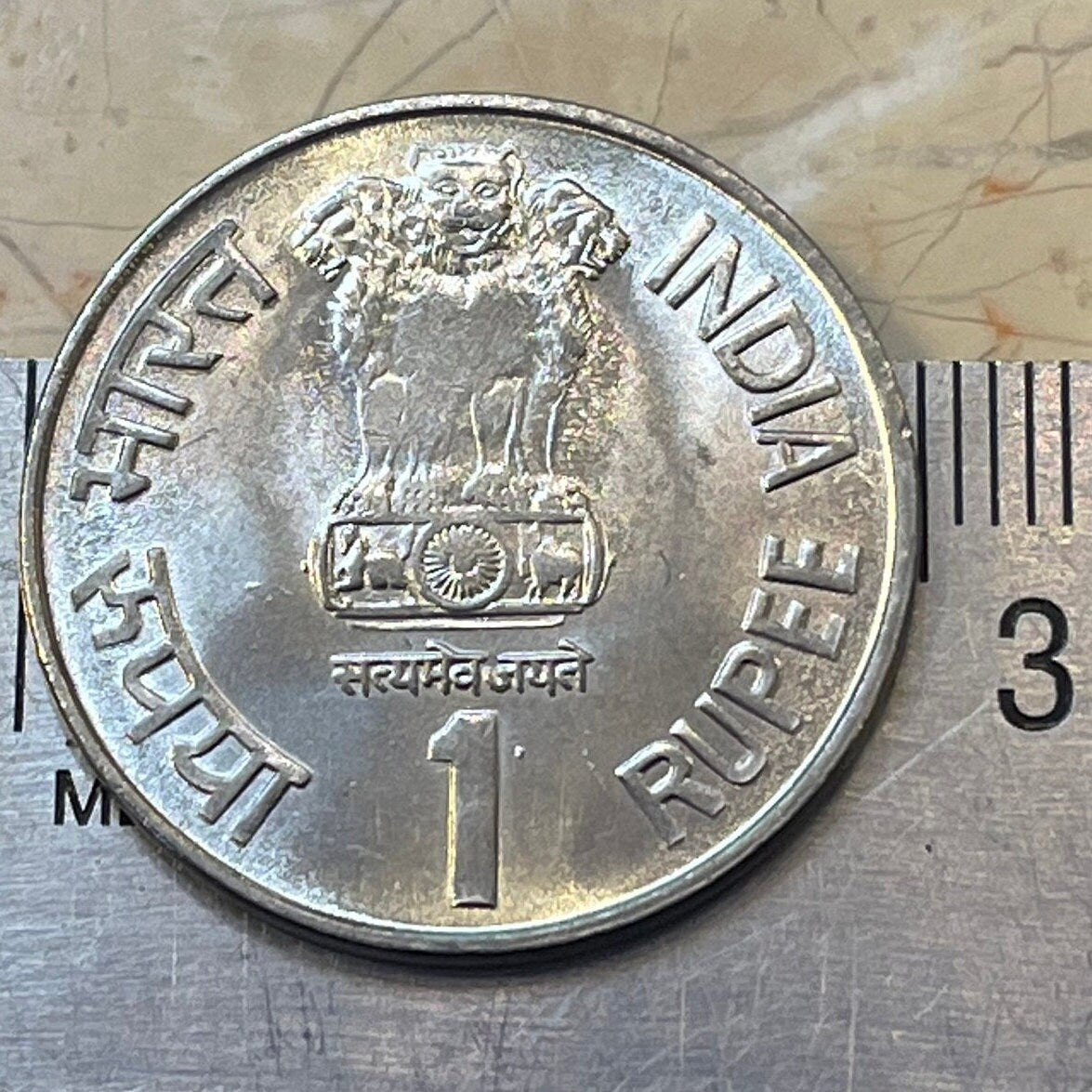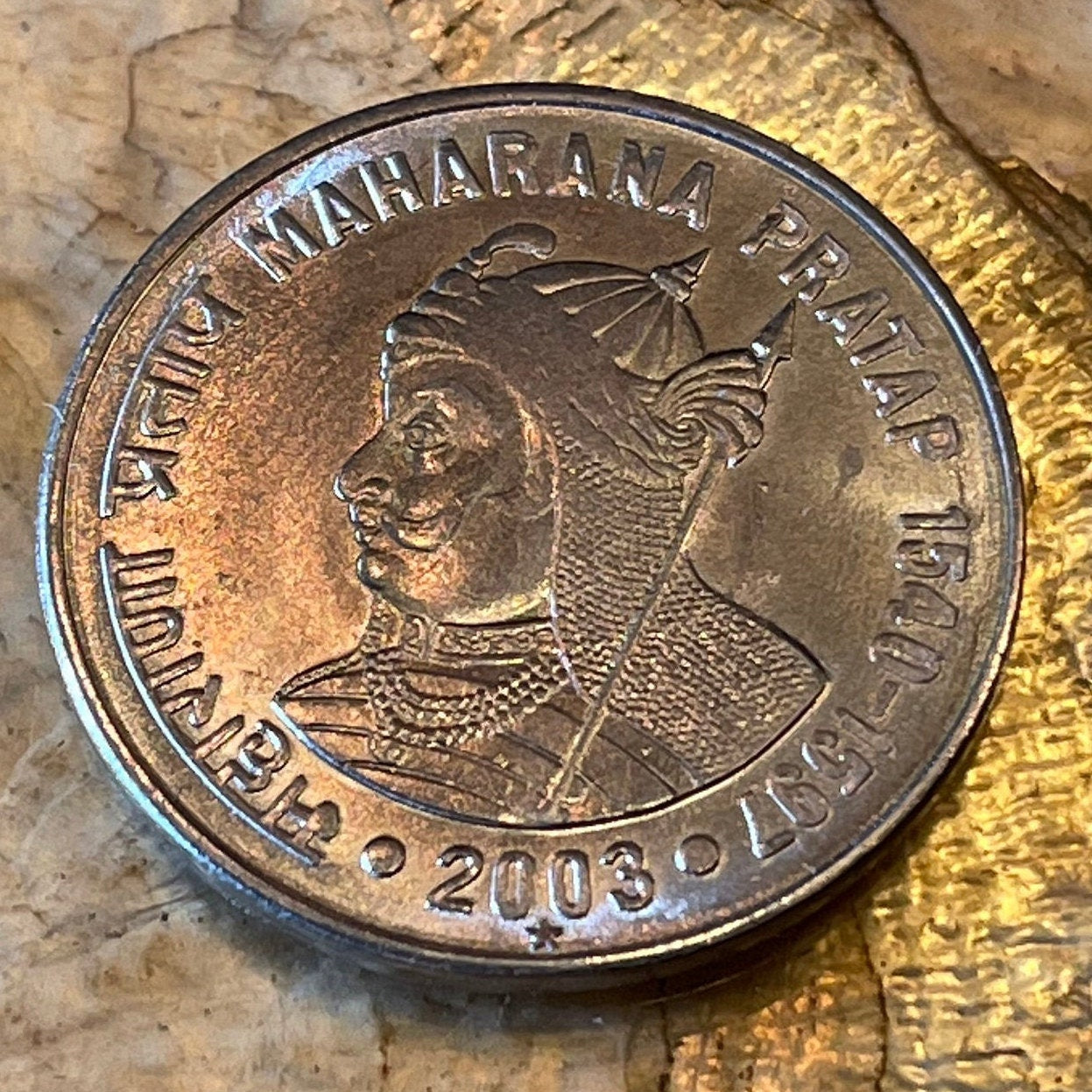elemintalshop
Maharana Pratap & Ashoka Lion Capitol 1 Rupee India Rajasthan Authentic Coin Money for Jewelry and Craft Making (Pratap Singh I)
Maharana Pratap & Ashoka Lion Capitol 1 Rupee India Rajasthan Authentic Coin Money for Jewelry and Craft Making (Pratap Singh I)
Couldn't load pickup availability
Maharana Pratap & Ashoka Lion Capitol 1 Rupee India Rajasthan Authentic Coin Charm for Jewelry and Craft Making (Pratap Singh I)
Commemorative issue: Maharana Pratap
Obverse: Asoka lion pedestal, denomination below
Lettering:
भारत INDIA
सत्यमेव जयते
रुपया 1 RUPEE
Reverse:Bust of Maharana Pratap facing left
Lettering:
महाराणा प्रताप MAHARANA PRATAP 1540 - 1597
Features
Issuer India
Period Republic (1950-date)
Type Circulating commemorative coin
Year 2003
Value 1 Rupee
1 INR = USD 0.013
Currency Rupee (decimalized, 1957-date)
Composition Stainless steel
Weight 4.95 g
Diameter 25 mm
Shape Round
Technique Milled
Orientation Medal alignment ↑↑
Number N# 5677
References KM# 314
Wikipedia:
Pratap Singh I (9 May 1540 – 19 January 1597), popularly known as Maharana Pratap, was a king of Mewar, a region in north-western India in the present-day state of Rajasthan. He was titled as "Mewari Rana" and was notable for his military resistance against the expansionism of the Mughal Empire and was known for his participation in the Battle of Haldighati and Battle of Dewair.
Legacy
Maharana Pratap is a prominent figure in both folk and contemporary Rajasthani culture and is viewed as a celebrated warrior in that state, as well as in India as a whole.
Historian Satish Chandra notes -
"Rana Pratap's defiance of the mighty Mughal empire, almost alone and unaided by the other Rajput states, constitute a glorious saga of Rajput valour and the spirit of self sacrifice for cherished principles. Rana Pratap's methods of guerrilla warfare was later elaborated further by Malik Ambar, the Deccani general, and by Shivaji".
Bandyopadhyay also seconds Satish Chandra's view with the observation that Pratap's successful defiance of Mughals using guerrilla strategy also proved inspirational to figures ranging from Shivaji to anti-British revolutionaries in Bengal.
Early life and accession
Maharana Pratap was born in a Hindu Rajput family. He was born to Udai Singh II and Jaiwanta Bai. His younger brothers were Shakti Singh, Vikram Singh and Jagmal Singh. Pratap also had 2 stepsisters: Chand Kanwar and Man Kanwar. He was married to Ajabde Punwar of Bijolia and he had married 10 other women and was survived by 17 children including Amar Singh I. He belonged to the Royal Family of Mewar.[8] After the death of Udai Singh in 1572, Rani Dheer Bai wanted her son Jagmal to succeed him but senior courtiers preferred Pratap, as the eldest son, to be their king. The desire of the nobles prevailed. Udai Singh died in 1572, and Prince Pratap ascended the throne as Maharana Pratap, the 54th ruler of Mewar in the line of the Sisodia Rajputs. Jagmal swore revenge and left for Ajmer, to join the armies of Akbar, and obtained the town of Jahazpur as a Jagir as a gift in return for his help.
Military career
Battle of Haldighati
The bloody Siege of Chittorgarh in 1567-1568 had led to the loss of the fertile eastern belt of Mewar to the Mughals. However, the rest of the wooded and hilly kingdom in the Aravalli range was still under the control of Maharana Pratap . The Mughal emperor Akbar was intent on securing a stable route to Gujarat through Mewar; when Pratap Singh was crowned king (Maharana) in 1572, Akbar sent a number of envoys entreating him to become a vassal like many other Rajput leaders in the region. When the Maharana refused to personally submit to Akbar, war became inevitable.
The Battle of Haldighati was fought on 18 June 1576 between Pratap Singh and Akbar's forces led by Man Singh I of Amer. The Mughals were victorious and inflicted significant casualties among the Mewaris but failed to capture the Maharana. The site of the battle was a narrow mountain pass at Haldighati near Gogunda, modern day Rajsamand in Rajasthan. Pratap Singh fielded a force of around 3000 cavalry and 400 Bhil archers. The Mughals were led by Man Singh of Amber, who commanded an army numbering around 5000–10,000 men. After a fierce battle lasting more than six hours, the Maharana found himself wounded and the day lost. He managed to retreat to the hills and lived to fight another day.
Haldighati was a futile victory for the Mughals, as they were unable to kill or capture Pratap Singh, or any of his close family members in Udaipur. As soon as the empire's focus shifted north-west, Pratap and his army recaptured the western regions of his dominion.[16] While the sources also claimes that Pratap able to make a successful escape, the battle failed to break the deadlock between the two powers. Subsequently, Akbar led a sustained campaign against the Rana, and soon, Goganda, Udaipur, and Kumbhalgarh were all under his control.
Reconquest of Mewar
Mughal pressure on Mewar relaxed after 1579 following rebellions in Bengal and Bihar and Mirza Hakim's incursion into the Punjab. In 1582, Pratap Singh attacked and occupied the Mughal post at Dewair (or Dewar) in the Battle of Dewair. This led to the automatic liquidation of all 36 Mughal military outposts in Mewar. After this defeat, Akbar stopped his military campaigns against Mewar. The victory of Dewair was a crowning glory for the Maharana, with James Tod describing it as the "Marathon of Mewar". In 1585, Akbar moved to Lahore and remained there for the next twelve years watching the situation in the north-west. No major Mughal expedition was sent to Mewar during this period. Taking advantage of the situation, Pratap recovered Western Mewar including Kumbhalgarh, Udaipur and Gogunda. During this period, he also built a new capital, Chavand, near modern Dungarpur.
Death
Reportedly, Pratap died of injuries sustained in a hunting accident, at Chavand on 19 January 1597, aged 56. He was succeeded by his eldest son, Amar Singh I. On his death bed, Pratap told his son never to submit to the Mughals and to win Chittor back.
*********
Wikipedia:
The Lion Capital of Ashoka is a sculpture of four Asiatic lions standing back to back, on an elaborate base that includes other animals. A graphic representation of it was adopted as the official Emblem of India in 1950. It was originally placed on the top of the Ashoka pillar at the important Buddhist site of Sarnath by the Emperor Ashoka, in about 250 BCE during his rule over the Maurya Empire. The pillar, sometimes called the Aśoka Column, is still in its original location, but the Lion Capital is now in the Sarnath Museum, in the state of Uttar Pradesh, India. Standing 2.15 metres (7 feet) high including the base, it is more elaborate than the other very similar surviving capitals of the pillars of Ashoka bearing the Edicts of Ashoka that were placed throughout India several of which feature single animals at the top; one other damaged group of four lions survives, at Sanchi.
The capital is carved out of a single block of polished sandstone, and was always a separate piece from the column itself. It features four Asiatic Lions standing back to back. They are mounted on an abacus with a frieze carrying sculptures in high relief of an elephant, a galloping horse, a bull, and a lion, separated by intervening spoked chariot-wheels. The whole sits upon a bell-shaped lotus. The capital was originally crowned by a 'Wheel of Dharma' (Dharmachakra popularly known in India as the "Ashoka Chakra"), with 32 spokes, of which a few fragments were found on the site. A 13th-century replica of the Sarnath pillar and capital in Wat Umong near Chiang Mai, Thailand built by King Mangrai, preserves its crowning Ashoka Chakra or Dharmachakra. The wheel on the capital, below the lions, is the model for the one in the flag of India.jai hind
Share



















